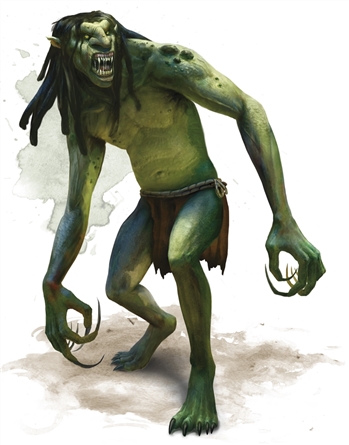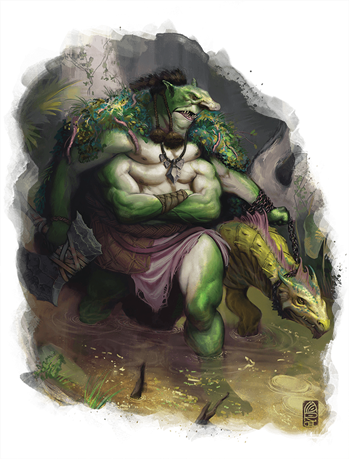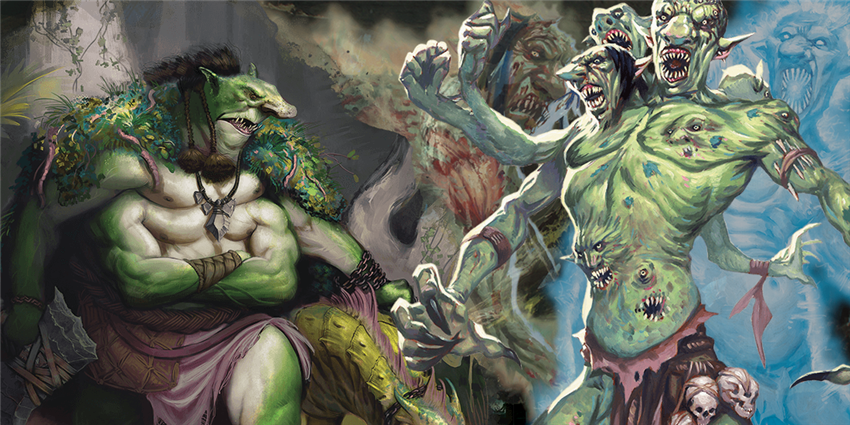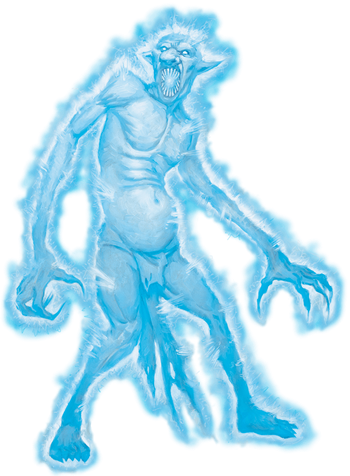"There! That will do it for the big lug!" the fighter exclaimed. She beamed, and wiped her blades against moss that carpeted the floor of the cave as the now-headless troll toppled to the ground. "That means it's your turn, thief. Let's pop open those chests it was guarding."
"I don't think that's such a good idea," the rogue stammered, backing away slowly from the fighter.
"Oh, why the long face, lightfingers?" the fighter laughed, putting her hands on her hips. "It's dead, I killed it myself. That thing ain't gonna hurt you now that he's dead. So why don't you go ahead and—"
"Get down!" bellowed the wizard. The fighter turned just in time to see the troll, now standing again, screw its severed head back into place and take an earth-shaking step towards her.
"What in the Nine Hells..." she gasped. The troll swung its wiry arm straight at her, and its dagger-like claws dug deep into flank. The fighter swore loudly and raised her swords again, breathing hard through the pain. "Okay, you big hunk of meat. You want to go again?"
"For the love of Mystra, I said get down!" the wizard snarled. The fighter listened to her companion this time, and hit the floor. The wizard summoned a mote of sickly green energy into his palms, and mimed holding a bow in one hand and drawing its string back in the other. An arrow of thrumming green energy formed in front of him, and whizzed through the air when he released his invisible bowstring. The arrow struck the troll with a wet, slippery burst, and droplets of neon green acid splashed all around the troll, eating holes through moss, stone, and flesh alike. The troll roared and hissed and wailed in pain and horror, then fell down to the ground, first incapacitated, and then, as the lingering acid of Melf's acid arrow dissolved its flesh, dead.
 Trolls are one of D&D’s most iconic monsters, because of their horrific powers of regeneration. Though trolls appear in countless European folkloric traditions, none possess the remarkable abilities that make D&D trolls so iconic. How can you leverage these powers of regeneration to make trolls deadly and terrifying foes for your characters to encounter?
Trolls are one of D&D’s most iconic monsters, because of their horrific powers of regeneration. Though trolls appear in countless European folkloric traditions, none possess the remarkable abilities that make D&D trolls so iconic. How can you leverage these powers of regeneration to make trolls deadly and terrifying foes for your characters to encounter?
The Power of Regeneration
Trolls in D&D are tall and lanky, with leathery green skin covered in horrific pustules and cancerous growths. Whenever a troll is wounded, its skin begins to stitch back together at an incredible pace. Even more frightful, a troll’s limbs regrow after being lopped off—and sometimes, these limbs can act with a mind of their own, or even grow an entirely new troll from a single severed limb! Only the cauterizing power of fire and acid can staunch a troll’s regenerative abilities for a time, and a slain troll can only be truly killed if its corpse is torched or dissolved after the beast is dead. Otherwise, this horrific survivor will continue to rise even from death’s door.
While trolls don’t possess this remarkable regenerative power in Scandinavian or English folklore, Gary Gygax did not imagine this ability into existence on his own. He was inspired by Three Hearts and Three Lions, a 1961 fantasy novel by Poul Anderson—a novel still proudly listed in Appendix E: Inspirational Reading of the Player’s Handbook. The troll Anderson’s hero battled in Three Hearts was the direct inspiration for D&D’s trolls, complete with a lanky frame and uncanny regenerative properties. If you want to enhance your narration when your characters fight a troll, consider turning to the original source and stealing a few lines from Anderson’s inspirational novel.
Standard Troll Tactics
 Trolls aren’t intelligent creatures. Unless your troll is an exceptional creature that has studied under a magical tutor or a masterful warlord (both interesting ideas, by the way!), you should avoid making keen tactical decisions when pitting a troll against your players. A troll in combat is a frothing berserker that fears neither death nor injury, for its body can recover from any wound. Its only fear are those elements that can prevent its regenerative abilities from saving it from death: fire and acid. Thus, it charges heedlessly towards its foes’ back ranks to eliminate the wizard in an iconic robe and pointed hat.
Trolls aren’t intelligent creatures. Unless your troll is an exceptional creature that has studied under a magical tutor or a masterful warlord (both interesting ideas, by the way!), you should avoid making keen tactical decisions when pitting a troll against your players. A troll in combat is a frothing berserker that fears neither death nor injury, for its body can recover from any wound. Its only fear are those elements that can prevent its regenerative abilities from saving it from death: fire and acid. Thus, it charges heedlessly towards its foes’ back ranks to eliminate the wizard in an iconic robe and pointed hat.
If combat has just begun and your party has a wizard or sorcerer that doesn’t outwardly appear magical, you may consider having the troll attempt to make a successful DC 15 Intelligence (Arcana) check with a –2 penalty to identify which characters in the party are capable of casting spells. Even if the troll fails this check, it will probably figure out which character is capable of dishing out fire or acid damage as soon as combat starts.
Ferociously attacking magic-users and foes that wield fire or acid is the extent of a troll’s tactical prowess. Beyond this, it may move around the battlefield erratically, provoking opportunity attacks seemingly for no purpose, just to attack the creature that has angered it the most. Even though trolls aren’t particularly intelligent, they know that dividing their attention between multiple opponents isn’t a sound strategy. Unless they have backup, a troll will typically focus all of its attacks in a single turn against a single foe, until that enemy falls unconscious. A troll that is taunted or seriously wounded may turn its attention to a new enemy.
Trolls in a Group
Trolls are chaotic creatures. Though they may serve evil humanoids, giants, and goblinoids as mercenaries, their masters should be aware that trolls ultimately follow the orders of only one creature: itself. Hobgoblins rankle when working with such lawless creatures, but will reshape their battle tactics around the troll’s erratic fighting style, using their Martial Advantage trait to opportunistically overwhelm whatever creature has earned the troll’s fickle ire.
Orc warbands love press-ganging trolls into acting as the vanguard for their hordes. An incensed troll can crash into an enemy line, forcing the orcs’ enemy to waste precious time hunting for flames and acid flasks while the orcish horde exploits the chaos of the troll’s attack to crush their enemies.
Whether they are being used by chaotic or lawful groups of evil creatures, trolls are always a wild card. They are engines of destruction to be unleashed and then acted around. Even evil wizards who wield fire can only keep a troll as a servant for so long, before the troll’s fury overwhelms its good sense and it tries to tear its captor apart.

Troll Variants
Trolls regrow in strange ways when they regenerate. Some trolls adapt to new surroundings with almost elf-like malleability, creating many different troll variants. Some of these unusual trolls are:
Many-Limbed Trolls
Some trolls have fairly simple mutations. A four-armed troll appears in Horde of the Dragon Queen (and a five-armed variant appears in Waterdeep: Dungeon of the Mad Mage), and a two-headed troll even appears in Out of the Abyss. These trolls don’t have improved intelligence or significantly different tactics than their unmutated kin, but they do attack with even greater ferocity, thanks to their improved offensive abilities.
Dire trolls are the ultimate expression of a mutant troll. These beings grow cancerously to immense size, and even attempt to graft other limbs onto their body to bolster their offenses. Even worse, their bulk allows them to partially regenerate even when wounded by fire and acid, making these trolls truly terrifying opponents.
Elemental Variants
Trolls exposed to potent elemental forces, or even just to severe climates, can take on certain elemental traits. Some are as simple as the ice troll that appears in Rise of Tiamat; its only unique trait is that it’s immune to cold damage.
 A more extreme example is the venom troll, which is not only immune to poison, but is also covered in pulsing, venom-filled pustules that explode when it is attacked. This venom-infused troll rushes into the heat of battle, not to pick off back-rank stragglers, but to get as close to as many foes at once, so that its venom can explode onto as many targets as possible. Some creatures, like kobolds or goblins, may take advantage of such a troll, and use their usually ineffectual slingstones to burst its venomous pustules while it’s fighting adventurers too powerful for these kobolds to fight on their own.
A more extreme example is the venom troll, which is not only immune to poison, but is also covered in pulsing, venom-filled pustules that explode when it is attacked. This venom-infused troll rushes into the heat of battle, not to pick off back-rank stragglers, but to get as close to as many foes at once, so that its venom can explode onto as many targets as possible. Some creatures, like kobolds or goblins, may take advantage of such a troll, and use their usually ineffectual slingstones to burst its venomous pustules while it’s fighting adventurers too powerful for these kobolds to fight on their own.
Likewise, the rot troll is a vile creature so suffused with necrotic energy that it loses its ability to regenerate. It is still a frenzied berserker that relishes surrounding itself with enemies, so that its Rancid Degeneration trait can wreak as much havoc as possible, but it is constantly searching for an escape route in case its situation gets too dire. These trolls work especially well with creatures like undead or constructs that are immune to necrotic damage, so that their Rancid Degeneration only affects their enemies, and not their allies.
Finally, a spirit troll is a troll that has been psychically evicted from its physical body while it was regenerating. It continues to exist as an incorporeal being, free from its former weaknesses while still possessing all of its deadly strengths. This incorporeal form has, however, granted it a few new weaknesses. Rather than its powers of regeneration being stymied by fire or acid, it is now arrested by psychic or force damage. Still, this fearsome incorporeal form positions the spirit troll as a powerful leader of lesser trolls, and troll hunters prepared with the fire and acid necessary to defeating its minions may be put into a bind when they are forced to contend with the unusual weaknesses of their ghostly leader.
 James Haeck is the lead writer for D&D Beyond, the co-author of Waterdeep: Dragon Heist and the Critical Role Tal'Dorei Campaign Setting, the DM of Worlds Apart, and a freelance writer for Wizards of the Coast, the D&D Adventurers League, and Kobold Press. He lives in Seattle, Washington with his partner Hannah and their feline adventurers Mei and Marzipan. You can usually find him wasting time on Twitter at @jamesjhaeck.
James Haeck is the lead writer for D&D Beyond, the co-author of Waterdeep: Dragon Heist and the Critical Role Tal'Dorei Campaign Setting, the DM of Worlds Apart, and a freelance writer for Wizards of the Coast, the D&D Adventurers League, and Kobold Press. He lives in Seattle, Washington with his partner Hannah and their feline adventurers Mei and Marzipan. You can usually find him wasting time on Twitter at @jamesjhaeck.








-
View User Profile
-
Send Message
Posted Apr 17, 2019Kenku Werebat !!
-
View User Profile
-
Send Message
Posted Apr 17, 2019I have a home brew one shot called “Temple of Vaprak” that is all about a troll that consumed enough sentient life that it evolved a greater intelligence and started worshipping Vaprak in a more active sense. He gains priest spells and starts organizing other trolls to build a full temple to Vaprak in an attempt to bring him into the material plain. He also has a unique ability where he can choose a troll within 30ft and forcibly mutate them using the power of Vaprak. It causes them to do things such as grow an extra arm and gain another swing. Their claws gain a paralytic toxin the players have to save against. Their claws grow razor sharp and can inflict bleeding wounds. And it can even cause the troll to mutate into another form like the variants you mentioned.
Also Umm may just be a weird mistake but why are you asking about lycanthropy in the last little blurb on an article about trolls? And I would do a Aarakokra werebear hehe.
-
View User Profile
-
Send Message
Posted Apr 17, 2019i think you misspelled hoard
(horde)
-
View User Profile
-
Send Message
Posted Apr 17, 2019In a campaign, many years ago, we encountered a rather powerful troll that had a pool of slimy water as the entrance to his lair. We thought we had adequately prepared to fight him.
What we didn't realize, when he burst out of the pool for a surprise attack on our party, was the slime provided him with immunity to fire and acid. Imagine the shock on the wizard's face when he cast Burning Hands and it didn't have an immediate effect of the troll! When Melf's Acid Arrow similarly failed to harm it, he became very distressed because all of the damage spells he had prepared were fire or acid-based.
The troll inflicted significant damage on the party, almost killing two party members, before our wizard finally burned off all the slime. Once the troll took "real" damage, he fled back into the pool and we departed the cave. Once we healed up in town, we returned with several vials of acid and a few flasks of Alchemist's Fire.....
-
View User Profile
-
Send Message
Posted Apr 17, 2019I love this. I love the boxed text as well. I don't think there are many dm's who use the regenerative ability to such an extent, which is a shame. I've never used a troll before but I think it's about time...
-
View User Profile
-
Send Message
Posted Apr 17, 2019No that's how you spell it
-
View User Profile
-
Send Message
Posted Apr 17, 2019Heya James, I think this one was pretty light. I think you could have really added something more around the use of the environment, time of day, other creature adds, etc to scale the DC. Trolls are one thing. Trolls where torches don’t light are another. A guide with a list of creative options on how to do this would be most welcome.
-
View User Profile
-
Send Message
Posted Apr 17, 2019"Horde" is an unruly army--e.g. the invading goblin hordes.
"Hoard" is a stash of something--e.g. the dragon sits on a hoard of gold.
-
View User Profile
-
Send Message
Posted Apr 17, 2019Thanks for this James. Gave me a great idea on a great one-shot adventure. I'll use the Troll like John Rambo from First Blood.
-
View User Profile
-
Send Message
Posted Apr 17, 2019You should make an article on slaadi.
-
View User Profile
-
Send Message
Posted Apr 17, 2019I would do [tortle wereboar] or [lizardfolk weretiger].
-
View User Profile
-
Send Message
Posted Apr 18, 2019This is so informative. Thank you so much. I might use some of these ideas in an upcoming campaign that I'm planning with friends.
-
View User Profile
-
Send Message
Posted Apr 18, 2019A few notions for actually playing trolls as unstoppable juggernauts, as the article is surprisingly light on ways to make players really hate these things.
>Consider having your players encounter trolls in heavily forested regions or other locations with abundant cover – and then make your troll cunning enough to use that cover as it advances. Trolls who’ve survived encounters with adventurers before could be expected to know that the fragile ones in the back like to throw their weaknesses at them from a distance – a ‘Relentless Survivor’ doesn’t need to be finely educated to know how to keep trees, boulders, and other objects between itself and elemental snipers.
>As others have mentioned, some environmental effects such as the troll covering itself in mud or slime, can provide the troll with brief protection against fire and acid. You shouldn’t go overboard on this, but even just one or two ‘safe’ rounds can allow the troll to close the distance to your players and start doing what it does best. This could also be used as a sort of makeshift camouflage, improving the troll’s Stealth rolls if it takes a dip in the mud before striking.
>Similarly, the weather could have an effect on a troll battle. Consider the tension of your players hunting a troll in a driving rainstorm – the rain not only limits visibility and makes it difficult to hear the troll coming, but it dampens fire and washes off acid. Your players may need to deal a certain amount of fire or acid damage on a turn to keep the troll from regenerating in such conditions, to represent the rain mitigating the effects of fire or acid on the beast – to say nothing of the troll’s ability to ambush the party during inclement weather and the difficulty of using torches, the most common source of fire available to non-spellcasters, in the rain.
Trolls are often encountered in a cave or somewhere else that amounts to a gladiatorial arena, but remember – trolls are predators, not gladiators. They exist to hunt and feed, not to fight. Next time your party’s dismissive of trolls, consider sending them against a troll in the Mud Forests of Deeprock during a rainstorm while your regenerating death beast Schwarzenegger’s its way around the party. It might make for a fun reality check.
-
View User Profile
-
Send Message
Posted Apr 18, 2019Very good! Thank you for these.
-
View User Profile
-
Send Message
Posted Apr 19, 2019I ran a party through an encounter with a group of trolls where a PC died during the encounter. A troll due to its ravenous nature, began to eat the corpse in the midst of melee. The players were so shook up that, the players, had their PCs Flee the encounter. After the session a player remarked that in years of playing D&D he had seen trolls kill PCs, but never eat the PC.
-
View User Profile
-
Send Message
Posted Apr 19, 2019Demonstrably in a troll's nature!
-
View User Profile
-
Send Message
Posted Apr 19, 2019Hey James, do you think you could do an article on how to run a succubus. I need to know so I can run RoT better.
Great article by the way.
-
View User Profile
-
Send Message
Posted Apr 20, 2019This really makes me wonder how trolls reproduce. Do they go into heat and start lobbing off body parts, in the hopes that one or more pieces will grow a new body? Is it accidental reproduction, when they lose a body part in combat? Being such chaotic creatures, do they actively seek out a mate, or even have family units? Or is it a combination of things?
-
View User Profile
-
Send Message
Posted Apr 21, 2019My players recently took a bounty to hunt and kill what turned out to be a venom troll. The fight was really rough, nobody knew prior to the fight what such a troll was capable of. Two of the 4 were knocked out by the end due to the massive amounts of damage the front line sustained from the creature's acidic blood. They took its head as a trophy assuming that some fire applied to the stump would keep it from regenerating. They got back to town just after dark, impaled the head on a bedpost at the inn they were staying at and went to sleep.
Needless to say, the next morning the head was gone. At first they assumed that someone had stolen it to claim the generous bounty, but some crime-scene investigation revealed that the head managed to escape on its own. Following a set of gradually enlarging footprints, they tracked the creature to a grassy field outside town, and had to battle it again. Things went a little smoother the second time around, but they still took a lot of damage.
Bloodied, burnt, and scarred, the party limped back to town with what was now just a bundle of ashes. The best part? Nobody in the little town could afford to pay the bounty. The person who had posted it straight up lied about the money and the party had to reluctantly settle on a pair of pigs and a couple sheep as payment.
-
View User Profile
-
Send Message
Posted Apr 21, 2019You know, I could imagine a venom troll being chained with a strong arcane magic/ lock spell in a cave. When the players go to investigate it, kobolds just pop out from behind the rocks popping its venom sacks with their slings, dealing a lot of poison damage. I should probably try that...